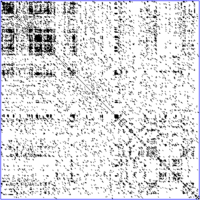Pairwise alignment
 Pairwise sequence alignment methods are used to find the best-matching piece wise (local) or global alignments of two query sequences. Pairwise alignments can only be used between two sequences at a time, but they are efficient to calculate and are often used for methods that do not require extreme precision (such as searching a database for sequences with high similarity to a query). The three primary methods of producing pairwise alignments are dot-matrix methods, dynamic programming, and word methods; however, multiple sequence alignment techniques can also align pairs of sequences. Although each method has its individual strengths and weaknesses, all three pairwise methods have difficulty with highly repetitive sequences of low information content - especially where the number of repetitions differ in the two sequences to be aligned. One way of quantifying the utility of a given pairwise alignment is the 'maximum unique match' (MUM), or the longest subsequence that occurs in both query sequences. Longer MUM sequences typically reflect closer relatedness.
Pairwise sequence alignment methods are used to find the best-matching piece wise (local) or global alignments of two query sequences. Pairwise alignments can only be used between two sequences at a time, but they are efficient to calculate and are often used for methods that do not require extreme precision (such as searching a database for sequences with high similarity to a query). The three primary methods of producing pairwise alignments are dot-matrix methods, dynamic programming, and word methods; however, multiple sequence alignment techniques can also align pairs of sequences. Although each method has its individual strengths and weaknesses, all three pairwise methods have difficulty with highly repetitive sequences of low information content - especially where the number of repetitions differ in the two sequences to be aligned. One way of quantifying the utility of a given pairwise alignment is the 'maximum unique match' (MUM), or the longest subsequence that occurs in both query sequences. Longer MUM sequences typically reflect closer relatedness.















0 comments:
Post a Comment
We will get back to you as soon as possible and thanks for the comment.